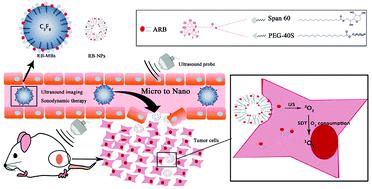当前位置:
X-MOL 学术
›
Biomater. Sci.
›
论文详情
Our official English website, www.x-mol.net, welcomes your feedback! (Note: you will need to create a separate account there.)
In situ conversion of rose bengal microbubbles into nanoparticles for ultrasound imaging guided sonodynamic therapy with enhanced antitumor efficacy.
Biomaterials Science ( IF 6.6 ) Pub Date : 2020-05-06 , DOI: 10.1039/c9bm02046b Rui Hou 1 , Xiaolong Liang 2 , Xiaoda Li 1 , Xu Zhang 1 , Xiaotu Ma 3 , Fan Wang 4
Biomaterials Science ( IF 6.6 ) Pub Date : 2020-05-06 , DOI: 10.1039/c9bm02046b Rui Hou 1 , Xiaolong Liang 2 , Xiaoda Li 1 , Xu Zhang 1 , Xiaotu Ma 3 , Fan Wang 4
Affiliation

|
Sonodynamic therapy (SDT) is a prospective therapy for many tumors by activation of sonosensitizers to produce reactive oxygen species (ROS) by ultrasound (US). However, limited generation of ROS and low drug delivery efficiency of sonosensitizers to the tumor tissue still hinder the application of SDT. Herein, an amphiphilic rose bengal (ARB) conjugate was designed to fabricate rose bengal microbubbles (RB-MBs) with high drug-loading contents (∼6.8%) and excellent contrast enhancement capability for US imaging, well suited for detecting tumor location and size. More importantly, RB-MBs could be successfully converted into RB-NPs by local US exposure, resulting in ∼7.5 times higher drug accumulation at the tumor tissue through the sonoporation effect as compared to RB-NPs and RB-MBs without US sonication. Meanwhile, using RB as the MB shell facilitated US energy transfer by the US mediated collapse of MBs through either a sonoluminescence or pyrolysis process; thus, the ROS generation efficiency could be greatly enhanced, resulting in a significantly higher tumor inhibition rate for the RB-MBs + US (∼76.5%) in the HT-29 tumor model as compared to conventional MBs + US and RB-NPs + US (∼23.8% and ∼49.2%), respectively. All these results suggested that this novel sonosensitizer delivery system of RB-MBs combined with US is a powerful strategy for remarkably enhancing SDT therapeutic efficacy with minimal side effects, showing great potential in cancer theranostics.
中文翻译:

玫瑰孟加拉微泡原位转化为纳米粒子,用于超声成像引导的声波动力疗法,具有增强的抗肿瘤功效。
声动力疗法(SDT)是通过激活超声增敏剂通过超声(US)产生活性氧(ROS)的方法,可用于许多肿瘤。然而,ROS的生成有限以及声敏剂向肿瘤组织的低药物递送效率仍然阻碍了SDT的应用。本文中,设计了两亲性玫瑰孟加拉(ARB)共轭物,以制造具有高载药量(〜6.8%)的玫瑰孟加拉微气泡(RB-MBs)和出色的对比度增强能力(适用于美国成像),非常适合检测肿瘤的位置和大小。更重要的是,通过局部超声暴露,RB-MBs可以成功地转化为RB-NPs,与没有超声处理的RB-NPs和RB-MBs相比,通过声波穿孔作用在肿瘤组织处的药物蓄积高约7.5倍。与此同时,使用RB作为MB壳,通过声致发光或热解过程,由美国介导的MB塌陷促进了美国的能量转移;因此,与传统的MBs + US和RB-NPs +美国(分别为23.8%和49.2%)。所有这些结果表明,这种新型的RB-MBs与US结合的声敏剂递送系统是一种显着提高SDT治疗效果且副作用极小的强大策略,在癌症治疗学中具有巨大潜力。与传统的MBs + US和RB-NPs + US相比,HT-29肿瘤模型对RB-MBs + US的肿瘤抑制率显着更高(〜76.5%),分别为23.8%和49.2%,分别。所有这些结果表明,这种新型的RB-MBs与US结合的声敏剂递送系统是一种显着提高SDT治疗效果且副作用极小的强大策略,在癌症治疗学中具有巨大潜力。与传统的MBs + US和RB-NPs + US相比,HT-29肿瘤模型对RB-MBs + US的肿瘤抑制率显着更高(〜76.5%),分别为23.8%和49.2%,分别。所有这些结果表明,这种新型的RB-MBs与US结合的声敏剂递送系统是一种显着提高SDT治疗功效且副作用极小的强大策略,在癌症治疗学中具有巨大潜力。
更新日期:2020-02-28
中文翻译:

玫瑰孟加拉微泡原位转化为纳米粒子,用于超声成像引导的声波动力疗法,具有增强的抗肿瘤功效。
声动力疗法(SDT)是通过激活超声增敏剂通过超声(US)产生活性氧(ROS)的方法,可用于许多肿瘤。然而,ROS的生成有限以及声敏剂向肿瘤组织的低药物递送效率仍然阻碍了SDT的应用。本文中,设计了两亲性玫瑰孟加拉(ARB)共轭物,以制造具有高载药量(〜6.8%)的玫瑰孟加拉微气泡(RB-MBs)和出色的对比度增强能力(适用于美国成像),非常适合检测肿瘤的位置和大小。更重要的是,通过局部超声暴露,RB-MBs可以成功地转化为RB-NPs,与没有超声处理的RB-NPs和RB-MBs相比,通过声波穿孔作用在肿瘤组织处的药物蓄积高约7.5倍。与此同时,使用RB作为MB壳,通过声致发光或热解过程,由美国介导的MB塌陷促进了美国的能量转移;因此,与传统的MBs + US和RB-NPs +美国(分别为23.8%和49.2%)。所有这些结果表明,这种新型的RB-MBs与US结合的声敏剂递送系统是一种显着提高SDT治疗效果且副作用极小的强大策略,在癌症治疗学中具有巨大潜力。与传统的MBs + US和RB-NPs + US相比,HT-29肿瘤模型对RB-MBs + US的肿瘤抑制率显着更高(〜76.5%),分别为23.8%和49.2%,分别。所有这些结果表明,这种新型的RB-MBs与US结合的声敏剂递送系统是一种显着提高SDT治疗效果且副作用极小的强大策略,在癌症治疗学中具有巨大潜力。与传统的MBs + US和RB-NPs + US相比,HT-29肿瘤模型对RB-MBs + US的肿瘤抑制率显着更高(〜76.5%),分别为23.8%和49.2%,分别。所有这些结果表明,这种新型的RB-MBs与US结合的声敏剂递送系统是一种显着提高SDT治疗功效且副作用极小的强大策略,在癌症治疗学中具有巨大潜力。


























 京公网安备 11010802027423号
京公网安备 11010802027423号